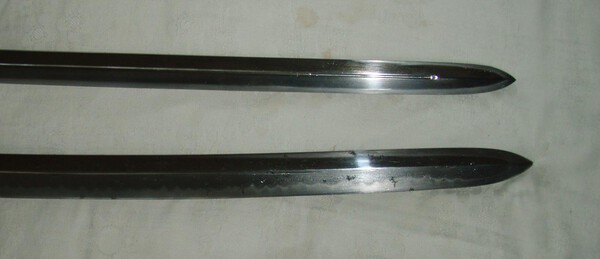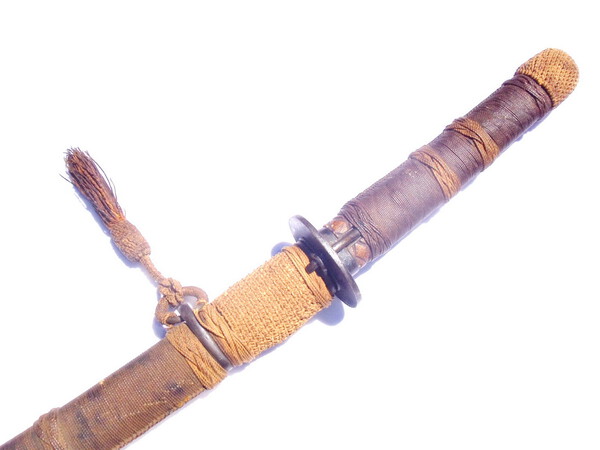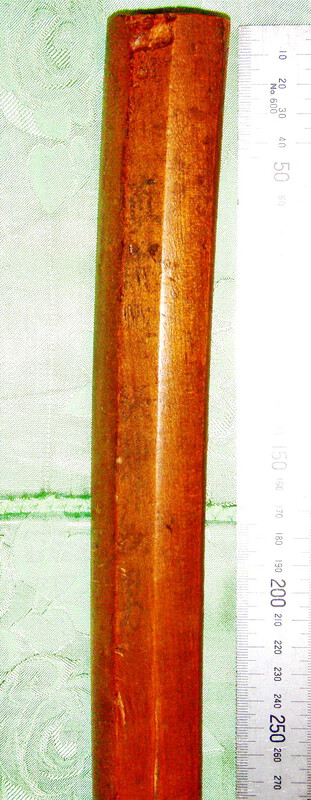-
Posts
422 -
Joined
-
Last visited
-
Days Won
9
Content Type
Profiles
Forums
Events
Store
Downloads
Gallery
Everything posted by Stegel
-
Bruce, there are 2 books by Fuller & Gregory, the one you refer to is the 1986 edition, a later 1996 edition(out of print) is better, with more info. Steve, do you have any pics of the other un-recognised patterns and the vulcanised rubber scabbard examples, to show us?? The white painted versions, are winter camo. It is an off-white colour, and over the years i have seen quite a few.
-

Early Murata-To, And How To Id Them
Stegel replied to lonely panet's topic in Military Swords of Japan
I didn't realise that you were asking for answers Hamish!! i thought you were going to explain more on these, sorry about that. We're both looking for info i suppose. I was looking about on the web and found this one, it has the same style tang as mine, but mine is mumei from memory. http://www.japanesesword.com/Images/Swords/06/1106/1106gunto7/1106gunto7.html -

Early Murata-To, And How To Id Them
Stegel replied to lonely panet's topic in Military Swords of Japan
Hi I have what may be a murata blade, (i don't know for sure) It is of the Kogarusa maru style, the hamon is a straight type. Here are some pics of the blade with another gunto by Kanenori, also the same style of blade. (not straight hamon) I couldn't find any of the tang, so i'll try to take some over the weekend when i get time, but it has from memory the screw type mount at the end. Are these generally oil-quenched?? -

Fun With My Late War Nco Gunto
Stegel replied to Bruce Pennington's topic in Military Swords of Japan
Thanks BP and Malcolm, very interesting. Like you Shamsy, i've never taken one apart to look either. -
You're right in what you say Brian, however it appears that these smaller 'crew' mounts were more prevalent with tank/pilot and submarine crews as indicated by Ohmura's link given by Dave previously. http://ohmura-study.net/977.html (there are 4 pages in total here) My understanding is that you could get anything from katana size,to wakizashi and even tanto, all in the official IJA/IJN koshirae. I have seen wakizashi in katana size koshirae, and i think this is where the confusion may lie. I've also seen "pilot" swords which had not army, but air force fittings (propellors instead of cherry blossoms), so the premise may seem correct. These smaller 'crew' mounts are presumed to be used by personnel in confined areas, although i personally cannot see them being of much benefit in a plane,tank or submarine (bar the space saving concept), as in reality they would be in deep sh*t if it come to that stage. For Samurai, they may have been useful indoors, but they never contended with bullets or grenades as much. Open to further opinions... Ern
-
Hi Thomas, Very nice indeed! What are the overall dimensions of yours?? I just looked at the original post sword for comparison and mine is 20.5 inches cutting edge with 33.5 inches overall compared to 21 1/8" and overall 31 1/2". My scabbard is about 3 3/4" longer than the blade. Sorry i've gone to imperial measurements to keep in line with the original posting. Even though it looks scaled in proportion, it could actually be a few inches shorter i believe. Ern
-
Shamsy, i'm not sure what is meant by "cut off gunto in shortened scabbard".... and also, the width of handle in mine is relatively similar to the standard version, just it being shorter, and the tanto version shorter again. I think this makes sense, as with my line of thinking, the grip needs to be the same for all standard personnel, we are not talking about miniturization to the point of it being scaled down like a pocket knife.
-
Hamfish, i believe the photo you have shown, shows the even smaller Tanto version. My naval sword is 850cm in mounts overall. The handle is about 3cm shorter than the normal issue. The blade is mumei with no Arsenal stampings whatsoever.
-
I'm 100% with Hamfish on this, i have a naval sword which is approx 1/3 smaller than the normal Naval issue. the handle is slightly shorter. My understanding is that crew gunto's , either army or navy are miniturized versions of the standard issue. This does not include wakizashi mounted in full length standard fittings, whether they be gunto or civilian mounts.
-

How Were Bo-Hi, Fuller Grooves, Made?
Stegel replied to Bruce Pennington's topic in Military Swords of Japan
Hi All, I find this stuff interesting, so thanks for your inputs guys. Is there any info regarding the mass produced blades from Showa period? I would imagine they were rolled on and not pressed, but i could be wrong. I couldn't see this craftmanship being used to churn out the type 32 or type 95 swords. Ern -

Nco Type 95 Shin Gunto Blade Manufacturing?
Stegel replied to Mark58's topic in Military Swords of Japan
Hamfish, perhaps you should refer to the second book by F&G......much more detail and info from the first 1986 edition which was about the only info you could get back then. Also on pg24, i think you have not read correctly the descriptions of the plates shown, as i did not interpret them the way you described. Ern The newer book is the 1996 editon, out of print and getting harder to find though. I have looked and cannot find the reference you make to mantetsu/gendai, in the first book.... -
Wow, you guys are quick!!! Thanks for the speedy replies! Not sure why someone would do this? What is the point, or rather what do they wish to achieve by this 'rework'? Ern
-
Hi All, I came across this whilst browsing the web, and have to admit i have never seen anything like it before. Has anyone else seen this shape of nakago before? It is obviously uncommon, but is there any reason for making it this way?? Cheers Ern
-
Hi All, just an update on the stamp appearing on the blade near the habiki. This came from a Japanese fellow on another forum by chance. Cisco san, is the tsuba on your one similar to the one on pg12 of this thread? Ern
-
Hi All, going by the information provided in the attachments, how can we determine what is cut Number 2 or 10 for that matter??? (perhaps a new pictorial diagram is needed for us newbies) Does not the inscription in gold (inlaid or laquered) indicate this??? /Ernst
-
-
Hi, I have seen this on both handles and scabbards before, here's a link to ebay which is active at the moment, http://www.ebay.com/itm/VERY-NICE-CUSTO ... 5d40d06cbd The seller refers to it as a: "Sword that was customized by U.S. Seaman with cord weaving and knot work during World War II, also known in the Navy as "Whiteline" and "Belfast"." i hope this helps. perhaps some other members who know for sure can help out more Here's a photo of a type 95 NCO with what was claimed to be in an 'as found' condition, indicating the Japanese soldier did the binding, it's not as elaborate as the other binding, but still interesting. Regards Ernst
-
Just bumping this along to see if there's any news on this logo yet. Ernst
-

Could anyone help with Saya translation please.
Stegel replied to Stegel's topic in Translation Assistance
Many thanks Koichi San! Also thanks for bringing the other thread to my attention, as i haven't seen it before. Ernst -
Hi, I obtained this bare blade with only habiki and saya last year. It caught my attention and was within my budget. The blade is out of polish, but is attributed to Muramasa and is apparently named? I'm a novice with normal Kanji and it takes me ages to get anywhere with translations, these are a bit more fancy in style and i'd be grateful for any help. I have adjusted the contrast to better see the faint writing on the saya, the reverse side is extremely faint. Thanks Ernst
-
Is it possible to submit a blade to shinsa and not have the mei considered? that is, covered up so as not to be visible and influence the appraisal? From what i've read so far, (and i have no experience of submitting blades) it appears that the shinsa team are to some degree money grabbers.... as Dire Straights put it... Money for nothing! as on their monopolised pedestal, they just say: Sorry it's a gimei..... bad luck, thanks for coming and by the way, thanks for coming, see you next time! No other info is offered as to 'who' they think made the blade??? Hmmm, perhaps they don't want to be embarrased ? but then again they are the experts and authorities in their field right??? so who would doubt or question them? This would tend me to agree with all the people who are of the opinion that papering is a waste of time and money. just a thought on their origins: Was the Shinsa team/organisation originally set up to try and recover 'valued' swords of national importance and they just progressed to todays organisation for milking collectors and making an economy by pushing up prices of blades with their paperwork?? Alex, i feel both Chris and Keith both gave honest opinions and views on the matter, reading this thread i didn't think it came across as demeaning, eliteist or arrogant, although i think the friend/foe option as suggested is a farce and should be removed...not promoted! After all we, all of us, always learn something, even if we disagree, so being an 'Adult' site((excuse the insinuation, but it's true), i think we should be civil enough to conduct ourselves appropriately. If i marked eveyone who made a shitty comment (in my opinion at the time), as a foe, well, what would be the use of visiting this site? what would i learn in the long run?? Ernst BTW- i had a few beers prior to making this post....no offence was intended to anyone...Lol
-
Denis is correct in stating the common text book knowledge, i know that NLF used the Navy 'dark' brown tassel as i have 2 such swords, both Army koshirae with naval tassels, the rest of the field gear such as Naval Land Garrison pattern service belts, and black leather scabbard covers identified them as NLF. I should add, i'm assuming so as i havn't seen them anywhere else, as they differ from the common Naval belts. One came directly from the returned serviceman in 1974, who shot the Japanese soldier himself. There were also other tassels of different colours used for civil/diplomatic purposes, see this link on Ohmura's web pages: http://www.k3.dion.ne.jp/~j-gunto/gunto_050.htm The page where he shows tassel's linked from the contents, shows the two different 'qualities' of tassel, the better having the opposing colour along the edge of the strap. Notice that the company grade is shown with blue and another with purplish blue, perhaps fading over the years or just a different manufacturers dye shade. I believe i read somewhere, but cannot recall the source, that late in the war (after or about the same time as the introducion of the type3 koshirae), ALL army tassels were newly issued as brown, a 'medium' brown which did not differentiate rank, as per Navy issue. I will try and find the reference if i can, and attach for you. Agree to disagree if you like, but i feel the 'Sniper' story still has credence. Sniper sees sword bearing soldier, sniper shoots, when there are groups of sword bearing soldiers, sniper gets picky... and starts to choose for a more valued target? If i was in the IJA, i wouldn't make my enemies job any easier, the sniper needs to look at other markings to confirm higher ranks, perhaps this could buy time? Stranger things have happened during the war, and i believe there is some method in their madness. I'm of the school of thought that once the medium brown tassels were introduced, they were supplied to both navy and army alike, hence explaining their presence on both type of gunto. Also Roy has a 'green' tassel on one of his swords, where are we to place that one? Naval suicide submarines? or are they just faded anomalies? Perhaps it is another classification as per Ohmura's web link above, but not yet documented. Perhaps he could put a pic of it on here for us to see? (please do Roy..) The floor is your's to comment as you see fit. Cheers Ernst BTW- In answer to the original question, i have seen both types of tassel on Type 3 guntos, i cannot vouch for their originality (as in being untampered with -post war), but it would explain why you find both types of tassel. Once the change came in, they were automatically issued the plain brown type instead of the blue/brown or red/brown.
-
I believe the sword is late war made in Manchuria, as it was considered a seperate country by the Japanese, (even after they occupied and 'colonised' it) they used a 15 and a 20 Stamen Plum Blossom instead of the traditional 5 Petal Cherry Blossom. I'm not sure if they were used on the tsuba's as i haven't come across any of these. My concern is with the quality of the fitting primarily. Does it appear genuine?? Ernst
-
Thanks John, Any ideas on the tang stamp or opinions on the Plum blossom? Ernst
-
Any one come across these before? I think it is a Manchurian made sword, late war. The 20 stamen Plum Blossom is supposed to be used instead of the 5 petal Cherry, from what i know, but it appears to be of low quality. Any comments?? Also, i have never seen a stamping on the blade itself, usually on the nakago. The stamp on the nakago has got me stumped as well. Thanks in advance Ernst
























